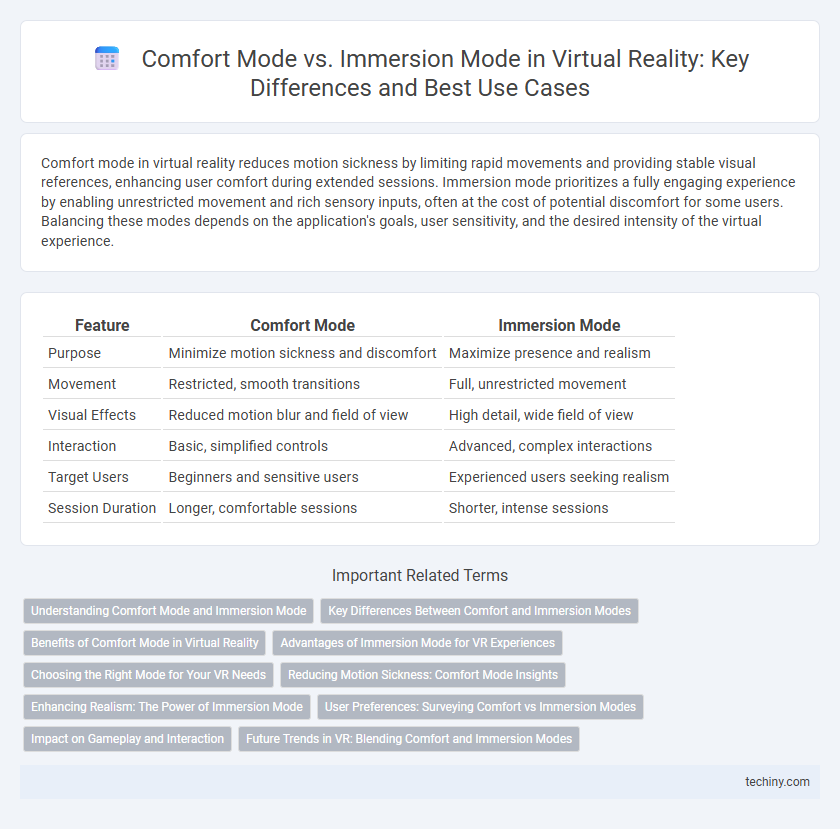Comfort mode in virtual reality reduces motion sickness by limiting rapid movements and providing stable visual references, enhancing user comfort during extended sessions. Immersion mode prioritizes a fully engaging experience by enabling unrestricted movement and rich sensory inputs, often at the cost of potential discomfort for some users. Balancing these modes depends on the application's goals, user sensitivity, and the desired intensity of the virtual experience.
Table of Comparison
| Feature | Comfort Mode | Immersion Mode |
|---|---|---|
| Purpose | Minimize motion sickness and discomfort | Maximize presence and realism |
| Movement | Restricted, smooth transitions | Full, unrestricted movement |
| Visual Effects | Reduced motion blur and field of view | High detail, wide field of view |
| Interaction | Basic, simplified controls | Advanced, complex interactions |
| Target Users | Beginners and sensitive users | Experienced users seeking realism |
| Session Duration | Longer, comfortable sessions | Shorter, intense sessions |
Understanding Comfort Mode and Immersion Mode
Comfort mode in virtual reality minimizes motion sickness and physical discomfort by reducing rapid movements and providing stable reference points, enhancing user tolerance during extended sessions. Immersion mode prioritizes sensory engagement and realism, utilizing full-range motion tracking, high-fidelity graphics, and spatial audio to deepen the sense of presence within virtual environments. Understanding the balance between comfort and immersion is crucial for VR developers to tailor experiences that suit diverse user needs and applications.
Key Differences Between Comfort and Immersion Modes
Comfort mode in virtual reality prioritizes reducing motion sickness and user fatigue through techniques like teleportation and limited head movement. Immersion mode enhances presence by enabling full locomotion and wide field-of-view interaction, increasing sensory engagement. Key differences lie in balancing usability and sensory fidelity, with comfort mode targeting accessibility and immersion mode maximizing realism.
Benefits of Comfort Mode in Virtual Reality
Comfort mode in Virtual Reality reduces motion sickness by minimizing rapid movements and visual discrepancies, enhancing user tolerance during extended sessions. It utilizes techniques such as snap turning and reduced field of view to maintain spatial orientation and prevent dizziness. This mode is ideal for VR beginners and users prone to discomfort, facilitating longer and more enjoyable virtual experiences.
Advantages of Immersion Mode for VR Experiences
Immersion mode in virtual reality enhances user presence by delivering high-fidelity visuals and spatial audio that closely mimic real-world environments, significantly reducing sensory disconnect. This mode exploits advanced tracking technologies and haptic feedback to create seamless interactivity, elevating engagement and user satisfaction. The heightened realism fosters deeper cognitive and emotional connections, making immersion mode ideal for training simulations, therapeutic applications, and immersive gaming experiences.
Choosing the Right Mode for Your VR Needs
Comfort mode in virtual reality minimizes motion sickness by limiting rapid movements and reducing field of view changes, making it ideal for beginners or extended sessions. Immersion mode prioritizes a fully realistic experience with dynamic visuals and unrestricted movement, suited for users seeking intense engagement and advanced gameplay. Selecting the right mode depends on individual tolerance to VR motion and the desired balance between comfort and realism.
Reducing Motion Sickness: Comfort Mode Insights
Comfort mode in virtual reality significantly reduces motion sickness by minimizing rapid or unnatural movements and incorporating stable reference frames. Techniques such as teleportation locomotion and field-of-view reduction are essential in maintaining user stability and preventing disorientation. These features create a more accessible VR experience by addressing sensory conflicts that commonly cause discomfort during extended sessions.
Enhancing Realism: The Power of Immersion Mode
Immersion mode in virtual reality significantly enhances realism by leveraging advanced haptic feedback, spatial audio, and dynamic environmental interactions that mimic real-world sensations. This mode prioritizes sensory engagement and reduces user distractions, creating a seamless integration between the virtual and physical experience. Unlike comfort mode, which limits motion and interaction to minimize discomfort, immersion mode delivers a fully embodied presence that heightens emotional and cognitive responses.
User Preferences: Surveying Comfort vs Immersion Modes
User preferences in virtual reality often balance comfort mode, which prioritizes reduced motion sickness and prolonged usability, against immersion mode, which emphasizes a more intense, realistic experience at the risk of discomfort. Surveys indicate that a majority of casual users favor comfort mode for extended sessions, while gamers and VR enthusiasts lean towards immersion mode for heightened sensory engagement. Insights from these preferences guide developers in creating customizable VR environments that adapt to varying tolerance levels and enhance overall user satisfaction.
Impact on Gameplay and Interaction
Comfort mode in virtual reality minimizes motion sickness by reducing rapid movements and smoothing transitions, enhancing player endurance during extended sessions. Immersion mode prioritizes realism with dynamic environments and full sensory feedback, intensifying user engagement and interaction complexity. Choosing between these modes directly impacts gameplay style, balancing accessibility and sensory richness for diverse player preferences.
Future Trends in VR: Blending Comfort and Immersion Modes
Future trends in virtual reality emphasize the integration of comfort and immersion modes to enhance user experience without sacrificing realism. Advanced haptic feedback, adaptive sensory controls, and AI-driven environment optimization are key technologies enabling seamless transitions between low-discomfort comfort settings and high-engagement immersive scenarios. These innovations aim to reduce VR-induced fatigue while maintaining deep user presence for extended sessions across gaming, training, and simulation applications.
Comfort mode vs Immersion mode Infographic

 techiny.com
techiny.com